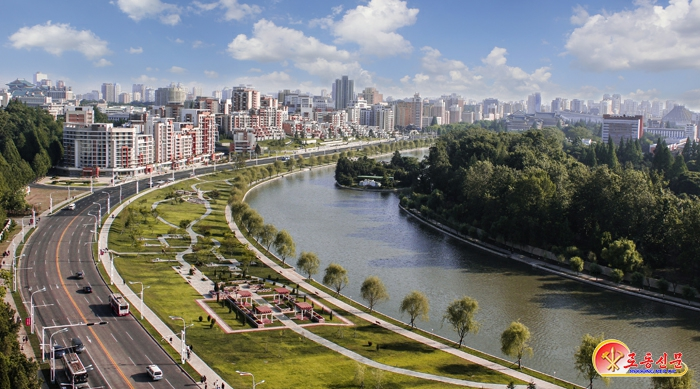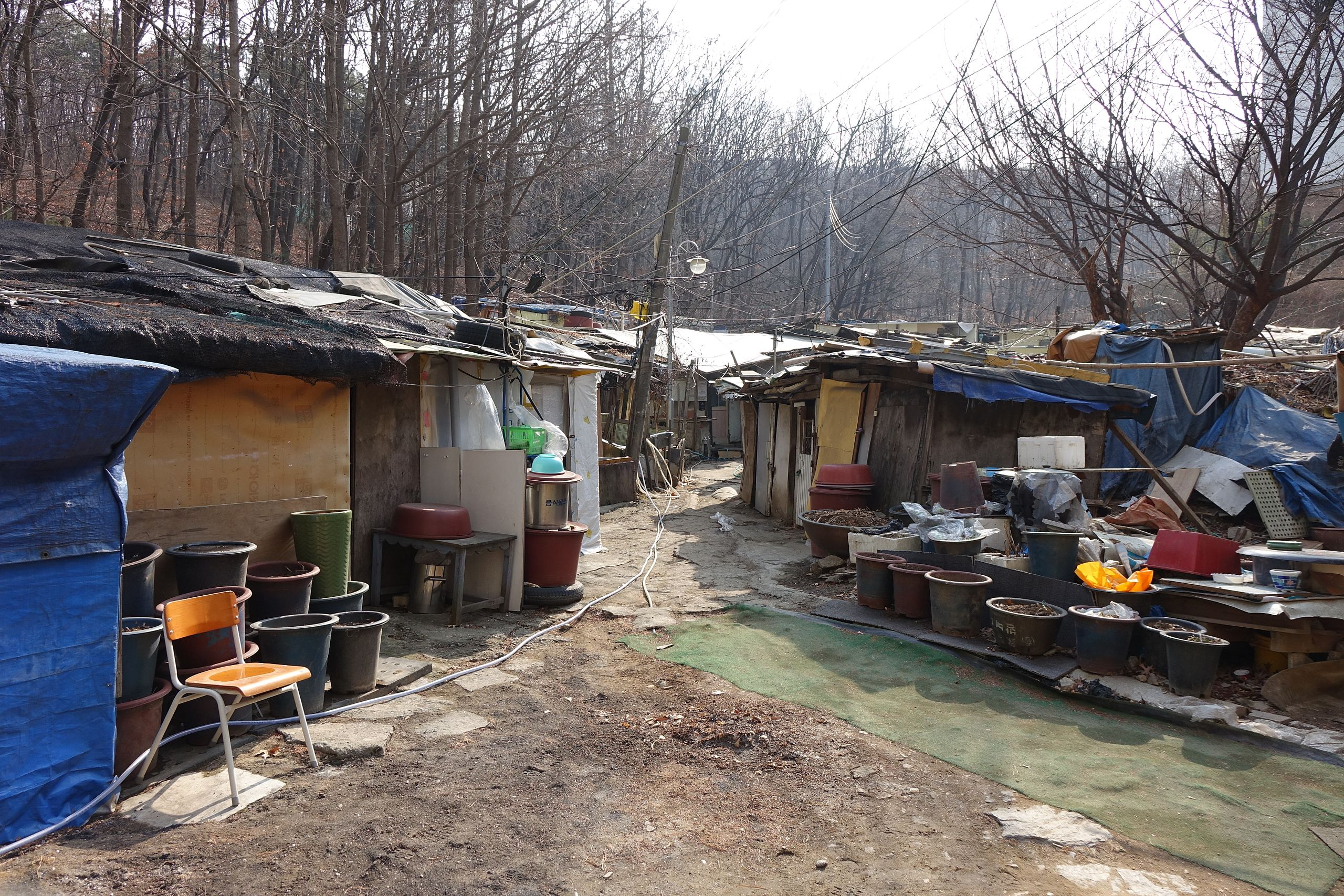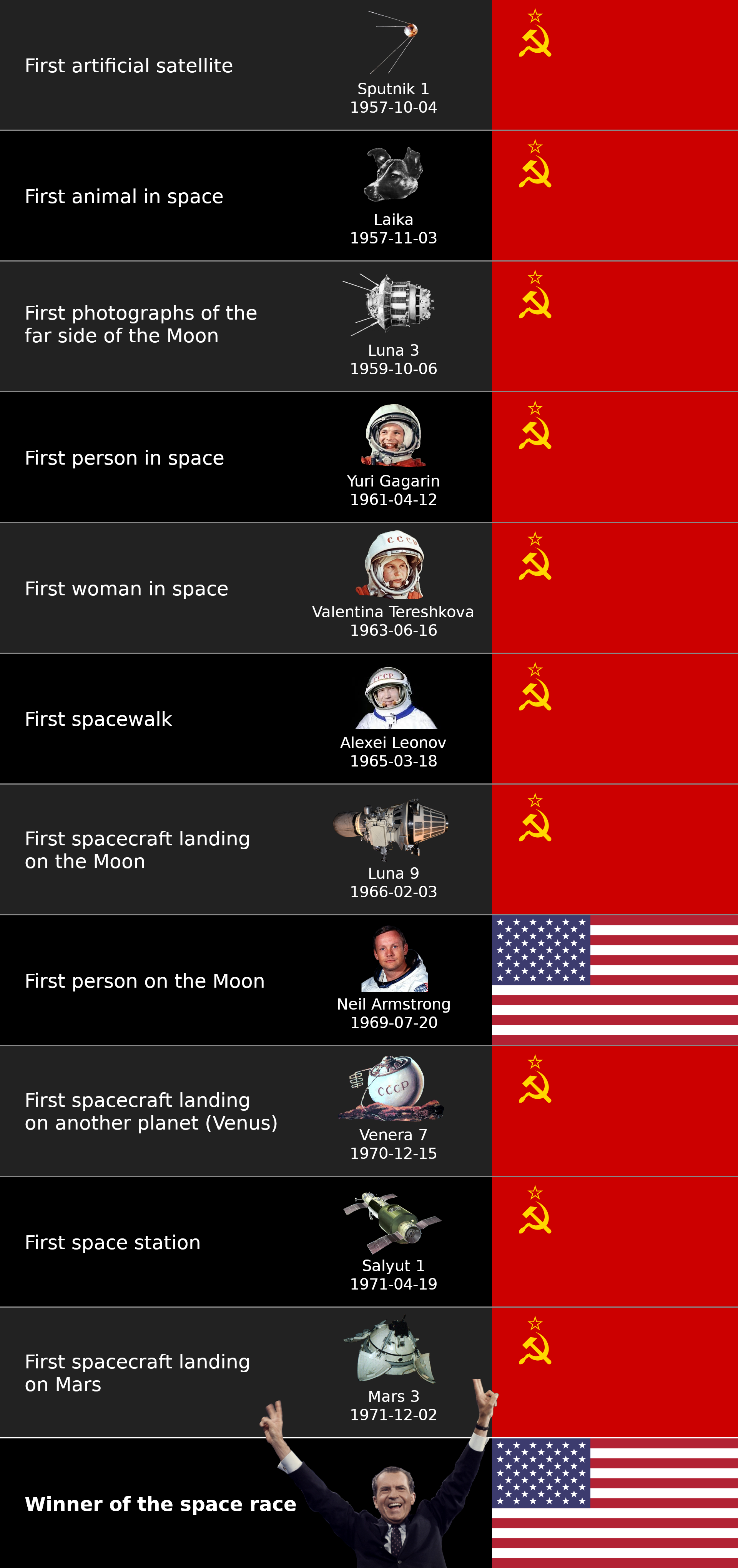More languages
More actions


The ruling class which owns the corporate media regularly demonizes the notions of socialism and communism to serve their own profit-seeking interests. They promote the idea that "socialism has failed everywhere it's been tried" (without mentioning the fact that these "failures" are oftentimes brought about through blockades, sanctions and CIA coups).
In addition to raising the basic living conditions of citizens,[1][2] socialist states have also produced valuable advances in the fields of science and technology, debunking the false claims that socialism cannot produce innovation.
USSR[edit | edit source]
The broad masses of pre-revolutionary Russia were deeply poor and lacked basic necessities, while only the upper class had access to education and healthcare.[3] Under the rule of the CPSU, the USSR increased living standards faster than any previous country in history and worked relentlessly to combat racism, sexism, and national oppression.[4]
Following the establishment of the USSR, the following rights were introduced to all citizens:
- The right to eight-hour work day.
- The right to annual paid leave.
- The right to three-year maternity leave.
- The right to free general and professional education, including higher education.
- The right to free health care.
- The right to use nurseries, kindergartens, and summer camps for free.
- The right to free sanatorium and spa treatment.
- The right to free housing.
- Equal rights for women.
Many of these rights forced Western bourgeois countries to adopt similar policies to stave off the risk of a proletarian revolution.
Living standards[edit | edit source]
Housing and basic food were subsidized in the USSR. Rent took up only 2–3% of a family's income and utilities only 4–5%. All citizens had the right to free education in arts and sciences.[4] Life expectancy increased from 30 years in 1900 to 62 in 1953. By 1975, Soviet life expectancy reached 71 years, within a year of the United States, and was more than two years longer than the non-white life expectancy in the U.S.[5] From 1928 to 1940, literacy rates increased from 46% to 80%.[6]
Economic development[edit | edit source]
The wealthiest people in the USSR earned only 10 times as much as the poorest, while corporate executives in the U.S. make hundreds of times more than their employees.[4]
Agriculture[edit | edit source]
During the First Five-Year Plan (1928–33), farm area grew by 11.7 million hectares, and the number of tractors and combine harvesters increased from 34,900 and 1,700 to 204,100 and 13,500, respectively. The Second Five-Year Plan (1933–38) doubled the number of sheep, goats, and hogs and increased the cattle population by 64.6%. The number of tractors continued to increase and reached 483,500.[7]
Industry[edit | edit source]
Soviet industrial production grew by an average of 11% per year from 1928 to 1940[8] and doubled between 1929 and 1933, the worst years of Great Depression.[9] In Russia, industry increased 151 times from 1913 to 1984 and 17 times from 1940 to 1984. It increased by more than 200 times in Kazakhstan and over 300 times in Kyrgyzstan since the First World War.[10] In 50 years, industrial production rose from 12% to 80% of the U.S. amount and agricultural production rose to 85% of the U.S. level.[4]
Space Race[edit | edit source]

During the Space Race between the two cold war superpowers, the USSR and the USA, the USSR achieved many great leaps before the US did.
- First artificial satellite: Sputnik 1
- First animal in space: Laika
- First photographs of the far side of the moon: Luna 3
- First person in space: Yuri Gagarin
- First woman in space: Valentina Tereshkova
- First spacewalk: Alexei Leonov
- First spacecraft landing on the moon: Luna 9
- First spacecraft landing on another planet (Venus): Venera 7
- First space station: Salyut 1
- First spacecraft landing on Mars: Mars 3
Notable technologies invented[edit | edit source]
The following are technologies not already listed in the space race section above
China[edit | edit source]
At the beginning of the 20th century, China was deeply impoverished due to external colonization and internal feudal relations which held back economic development. During this period, China was referred to as the "sick man of Asia."
When the Communist Party of China came to power in 1949, its leaders' fundamental long-range goals were to transform China into a modern, powerful, socialist nation. In economic terms these objectives meant industrialization, improvement of living standards, narrowing of income differences, and production of modern military equipment. The immense economic rise of China in the 21st century is, according to the Communist Party of China, the result of the application of Marxist theory to the material conditions of China.
At the time of the Chinese revolution, a fifth of land was devoted to opium production. The CPC eliminated drug addiction within two years of coming to power.[12]
End of warlordism[edit | edit source]
By 1952, the CPC cleared mainland China of bandits and warlords.[12]
Economic development[edit | edit source]
Between 1950 and 1952, agricultural production increased by 15% and the economy grew by an average of 25% every year. Heavy industry increased by 30 times between 1952 and 1979. Rural consumption of electricity increased by 71 times up to 1965. During the First Five-Year Plan (1952–57), industry grew by 128% and agriculture grew by 25%. Grain production increased by 46% from 1965 to 1975.[12]
Since 1978, the Chinese economy has grown an additional 37 times[12] with an average growth rate of 9.5%.[13] The average growth rate was 7.3% for 1975–1991 and 12.1% for 1992–1996.[14]
Living standards[edit | edit source]
Under the leadership of Chairman Mao, China's life expectancy rose from 38 to 68 years. It continued to increase after Mao's death and surpassed the U.S. to reach 78.2 years by 2022.[13]
In 1949, less than 20% of China's population was literate. Adult literacy rose to 57% by 1959 and now stands at 99.8% while the U.S. only has a literacy rate of 79%.[13]
Poverty alleviation[edit | edit source]
In the past 40 years, China has lifted 800 million people out of extreme poverty, accounting for three-quarters of global poverty reduction.[13] In the 1990s, only 10% of Chinese people lived in poverty compared to 20% in the much richer USA.[14]
Korea[edit | edit source]
Before the rise of socialism, workers worked 15-hour days with no paid vacations. Following the division of Korea, northern authorities shortened the work day to eight hours (seven for dangerous jobs), banned child labor, and established social security, paid vacations of two weeks to a month, and gender equality. Women made up 51% of the population and 49% of the workforce and had paid maternity leave and social programs to care for children.[15] Despite abolishing taxes in 1974 and suffering severe sanctions from the West, the DPRK continues to provide free healthcare and education to its citizens, and housing and food are very cheap.[16]
Eastern Europe[edit | edit source]
Germany[edit | edit source]
The German Democratic Republic had 100% employment and very cheap higher education.[17] Rent took up less than 10% of total income and evictions were illegal.[18] Between 1951 and 1989, its economy grew slightly faster than West Germany's with an annual growth rate of 4.5% to 4.3%.[19] The GDR had 24 doctors per 10,000 people by 1989, higher than the USA or UK.[20]
Romania[edit | edit source]
Under socialism, the Romanian life expectancy rose from 42 to 72 years. Industrial output rose by 650% from 1950 to 1989, and the government built 4.6 million houses. Women had paid maternity leave of 112 days.[21]
Latin America[edit | edit source]
Cuba[edit | edit source]
Despite the US blockade, Cuba is still able to boast having the highest quality healthcare system for its national income range.[22]
Cuba has a far higher standard of living than most of its neighbors, according to the very CIA which has plotted to destroy the communist Cuban government countless times.[23]
Nicaragua[edit | edit source]
Nicaragua, under the socialist Sandinista government, has diversified away from colonial-era cash crops and monocultures, delivered sustained economic growth, and alleviated poverty.[24]
Venezuela[edit | edit source]
Under Hugo Chávez, Venezuela's unemployment rate dropped from 14.5% to 7.6%, GDP per capita increased by 163%, infant mortality dropped from 2% to 1.3%, and extreme poverty dropped from 23.4% to 8.5%.[25]
See also[edit | edit source]
References[edit | edit source]
- ↑ Marcida Dodson (1986-06-07). "Quality of Life Higher in Socialist Nations, Study Says" Los Angeles Times.
- ↑ Hakim (2021-09-22). "Socialism is just better, scientifically"
- ↑ Commiedad (2016-11-25). "The Successes of Socialism in the USSR" Write to Rebel. Archived from the original.
- ↑ 4.0 4.1 4.2 4.3 J. Sykes (2022-12-11). "Red Theory: The achievements of socialism in the Soviet Union" Fight Back! News. Archived from the original on 2022-12-26. Retrieved 2023-02-05.
- ↑ Albert Szymanski (1984). Human Rights in the Soviet Union: 'Economic Rights' (pp. 136–137). [PDF] London: Zed Books Ltd.. ISBN 0862320186 [LG]
- ↑ Roger Keeran, Thomas Kenny (2010). Socialism Betrayed: Behind the Collapse of the Soviet Union: 'Two Trends in Soviet Politics' (pp. 18–25). [PDF] iUniverse.com. ISBN 9781450241717
- ↑ TheFinnishBolshevik (2016-08-07). "The results of the 1st & 2nd Five-Year Plans: Soviet industrial revolution." ML-Theory. Archived from the original on 2022-06-22. Retrieved 2022-08-07.
- ↑ Roger Keeran, Thomas Kenny (2010). Socialism Betrayed: Behind the Collapse of the Soviet Union: 'Two Trends in Soviet Politics' (pp. 18–25). [PDF] iUniverse.com. ISBN 9781450241717
- ↑ TheFinnishBolshevik (2016-08-07). "The results of the 1st & 2nd Five-Year Plans: Soviet industrial revolution." ML-Theory. Archived from the original on 2022-06-22. Retrieved 2022-08-07.
- ↑ Albert Szymanski (1984). Human Rights in the Soviet Union: 'The Asian Nationalities in the USSR' (p. 39). [PDF] London: Zed Books Ltd.. ISBN 0862320186 [LG]
- ↑ 11.0 11.1 11.2 11.3 10 Greastest Inventions Made By The Soviet Union
- ↑ 12.0 12.1 12.2 12.3 Harpal Brar (2021-06-30). "Greetings to the Communist Party of China on its 100th anniversary" Proletarian. Archived from the original on 2022-05-29. Retrieved 2022-12-04.
- ↑ 13.0 13.1 13.2 13.3 J. Sykes (2022-12-24). "Red Theory: The achievements of socialism in China" Fight Back! News. Archived from the original on 2023-01-23. Retrieved 2023-02-05.
- ↑ 14.0 14.1 Austin Murphy (2000). The Triumph of Evil: 'The Documented Facts about Eastern Europe and Communism' (p. 83). [PDF] Fucecchio: European Press Academic Publishing. ISBN 8883980026
- ↑ Stephen Gowans (2018). Patriots, Traitors and Empires: The Story of Korea’s Struggle for Freedom: 'The Patriot State' (pp. 88–93). [PDF] Montreal: Baraka Books. ISBN 9781771861427 [LG]
- ↑ Zak Brown (2023-11-18). "Towards a concrete analysis of the DPRK" Anti-Imperialism.org. Archived from the original on 2020-01-18. Retrieved 2023-03-12.
- ↑ Austin Murphy (2000). The Triumph of Evil: 'A Post-Mortem Comparison of Communist and Capitalist Societies Using the German Case as an Illustration' (pp. 94–102). [PDF] Fucecchio: European Press Academic Publishing. ISBN 8883980026
- ↑ Victor Grossman (2022-08-24). "My seventy years and the departed GDR" Monthly Review. Archived from the original on 2022-08-25. Retrieved 2022-08-26.
- ↑ Karl Mai (2009). GDR - FRG in an economic-statistical comparison 1950 to 1989 - On new results by Prof. Gerhard Heske (German: DDR – BRD im ökonomisch-statistischen Vergleich 1950 bis 1989 - Zu neuen Ergebnissen von Prof. Gerhard Heske). [PDF]
- ↑ "‘Socialism Is the Best Prophylaxis’: The German Democratic Republic’s Health Care System" (2023-02-14). Tricontinental. Archived from the original on 2023-02-14. Retrieved 2023-02-26.
- ↑ Patricia Gorky (2019-12-26). "Romania: 30 years removed from socialism" Liberation News. Archived from the original on 2022-03-19. Retrieved 2022-10-08.
- ↑ Mostly Anti-Cuba article that is forced to report cold hard facts: How Cubans Live as Long as Americans at a Tenth of the Cost by The Atlantic
- ↑ Ben Cohen (2018-10-09). "Cuba and the Success of Socialism" The Daily Banter.
- ↑ Nicaraguan Sandinista Economic Model Consolidates Its Success by TeleSur
- ↑ "How did Venezuela change under Hugo Chávez?". The Guardian. Archived from the original on 2023-04-24.
